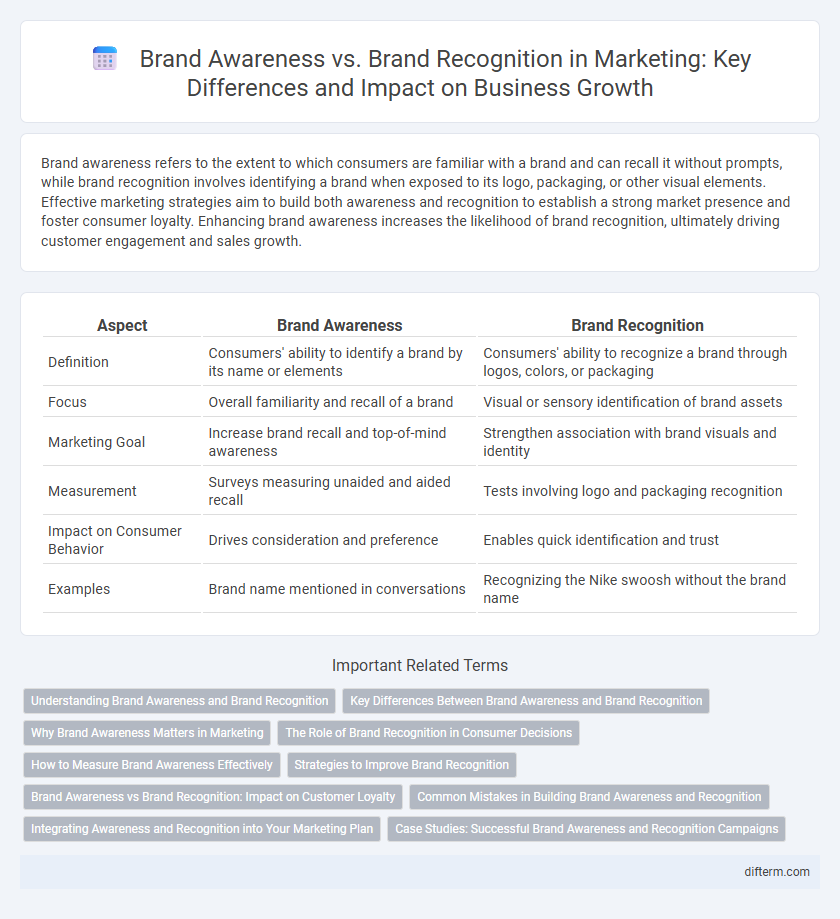Brand awareness refers to the extent to which consumers are familiar with a brand and can recall it without prompts, while brand recognition involves identifying a brand when exposed to its logo, packaging, or other visual elements. Effective marketing strategies aim to build both awareness and recognition to establish a strong market presence and foster consumer loyalty. Enhancing brand awareness increases the likelihood of brand recognition, ultimately driving customer engagement and sales growth.
Table of Comparison
| Aspect | Brand Awareness | Brand Recognition |
|---|---|---|
| Definition | Consumers' ability to identify a brand by its name or elements | Consumers' ability to recognize a brand through logos, colors, or packaging |
| Focus | Overall familiarity and recall of a brand | Visual or sensory identification of brand assets |
| Marketing Goal | Increase brand recall and top-of-mind awareness | Strengthen association with brand visuals and identity |
| Measurement | Surveys measuring unaided and aided recall | Tests involving logo and packaging recognition |
| Impact on Consumer Behavior | Drives consideration and preference | Enables quick identification and trust |
| Examples | Brand name mentioned in conversations | Recognizing the Nike swoosh without the brand name |
Understanding Brand Awareness and Brand Recognition
Brand awareness measures how well consumers can recall or identify a brand, reflecting the overall presence and visibility in the market, while brand recognition specifically evaluates the ability to confirm prior exposure when presented with a brand's visual elements or name. High brand awareness often leads to increased consumer trust and preference, influencing purchase decisions and customer loyalty. Effective marketing strategies leverage both concepts to build a strong brand identity, ensuring the brand remains memorable and easily identifiable among competitors.
Key Differences Between Brand Awareness and Brand Recognition
Brand awareness measures the overall familiarity and recall of a brand by consumers, encompassing both conscious and subconscious knowledge, while brand recognition specifically refers to the ability of consumers to identify a brand based on visual or sensory cues such as logos, colors, or packaging. Brand awareness reflects the depth of consumer engagement and emotional connection, influencing purchase decisions over time, whereas brand recognition is more immediate and often the first step in the customer journey toward brand loyalty. Effective marketing strategies leverage brand awareness to build trust and credibility, while brand recognition drives quick identification and differentiates a brand in competitive markets.
Why Brand Awareness Matters in Marketing
Brand awareness is crucial in marketing because it establishes a brand's presence in the consumer's mind, influencing purchase decisions and fostering customer loyalty. High brand awareness increases the likelihood of customer engagement by making the brand more familiar and trustworthy compared to competitors. Companies with strong brand awareness benefit from organic marketing advantages, including increased word-of-mouth referrals and higher brand equity.
The Role of Brand Recognition in Consumer Decisions
Brand recognition plays a crucial role in consumer decisions by enabling quick identification of products and fostering trust based on prior exposure. Unlike brand awareness, which measures consumer familiarity, brand recognition directly influences purchase choices through visual cues like logos and packaging. Enhanced brand recognition reduces decision-making time and increases the likelihood of repeat purchases, driving long-term customer loyalty.
How to Measure Brand Awareness Effectively
Measuring brand awareness effectively requires tracking key metrics such as aided and unaided brand recall through surveys and analyzing social media engagement rates and website traffic sources. Utilizing tools like Google Analytics and brand tracking studies provides quantifiable data on the reach and impact of marketing campaigns. Monitoring changes in search volume for branded keywords alongside sentiment analysis helps gauge consumer perception and the depth of brand recognition.
Strategies to Improve Brand Recognition
Effective strategies to improve brand recognition include consistent visual identity across all marketing channels, such as logos, colors, and typography, which enhance memory recall. Utilizing social media platforms to engage audiences with interactive content and influencer partnerships boosts visibility and strengthens association with the brand. Implementing targeted advertising campaigns and optimizing search engine presence ensures frequent exposure, reinforcing brand elements in consumers' minds.
Brand Awareness vs Brand Recognition: Impact on Customer Loyalty
Brand awareness establishes a customer's overall familiarity with a brand, influencing initial trust and preference, while brand recognition enables quick identification and recall of the brand in competitive markets. Higher brand awareness significantly boosts customer loyalty by fostering emotional connections and repeated engagement, leading to increased lifetime value. Consistent brand recognition reinforces loyalty through ease of choice, making customers more likely to repurchase and advocate for the brand.
Common Mistakes in Building Brand Awareness and Recognition
Confusing brand awareness with brand recognition leads to ineffective marketing strategies by overlooking the need for consistent visual elements and messaging that foster immediate recall. Common mistakes include neglecting targeted audience analysis and failing to differentiate the brand from competitors, which diminishes engagement and memorability. Prioritizing repetitive exposure through diverse channels without value-driven content weakens both brand awareness and recognition efforts.
Integrating Awareness and Recognition into Your Marketing Plan
Integrating brand awareness and brand recognition into your marketing plan enhances customer engagement by creating a memorable and easily identifiable brand image across multiple channels. Utilizing targeted content marketing, social media campaigns, and consistent visual branding strengthens both awareness and recognition, leading to increased trust and loyalty. Measuring key metrics such as brand recall, logo recognition, and social media impressions allows marketers to optimize strategies for sustained brand growth and market presence.
Case Studies: Successful Brand Awareness and Recognition Campaigns
Case studies of successful campaigns by Nike and Coca-Cola illustrate the impact of brand awareness through emotional storytelling and consistent visual identity, resulting in deep consumer engagement. Apple's brand recognition strategy leverages minimalist design and memorable logos, showcasing how distinct brand elements drive immediate consumer recall. These examples demonstrate the effectiveness of integrating brand awareness and recognition tactics to enhance market presence and consumer loyalty.
brand awareness vs brand recognition Infographic

 difterm.com
difterm.com